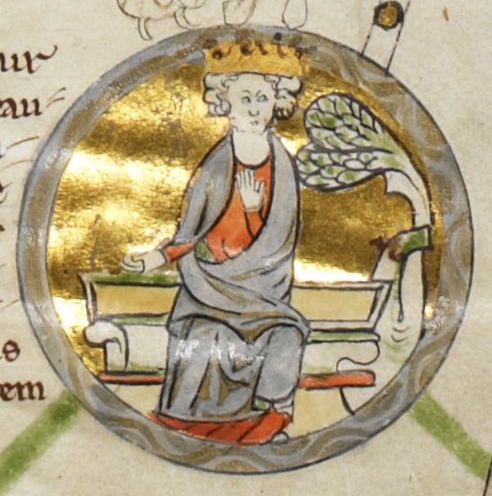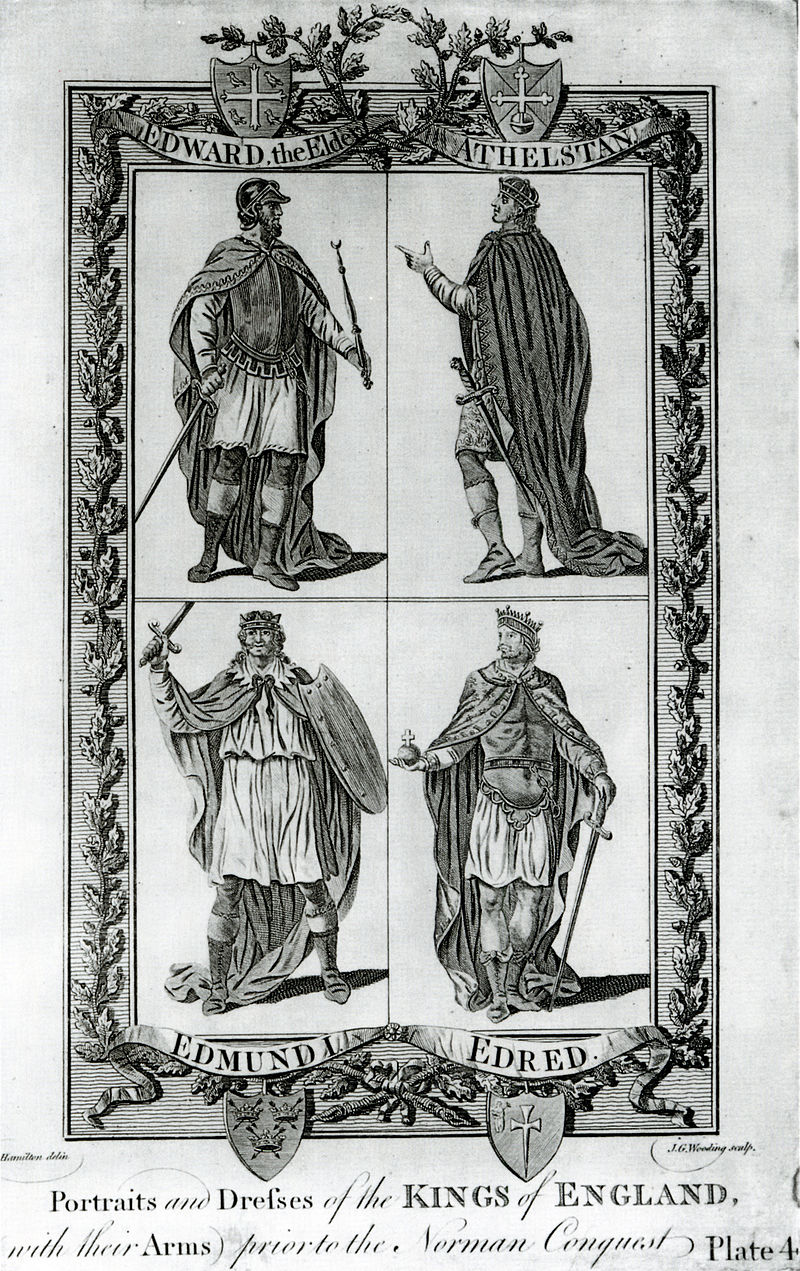by Susan Flantzer © Unofficial Royalty 2020

Edmund I, King of the English; Credit – Wikipedia
Edmund I, King of the English was born in 921, the elder of the two sons and the eldest of the three children of Edward the Elder, King of the Anglo-Saxons and his third wife Eadgifu of Kent, the daughter of Sigehelm, Ealdorman of Kent. He was also the grandson of Alfred the Great.
Edmund had two full siblings:
- Eadred, King of the English (923 – 955), unmarried
- Saint Eadburh of Winchester (died 960), a Benedictine nun at St Mary’s Abbey, Winchester
Edmund had two half-siblings from his father’s first marriage to Ecgwynn:
- Æthelstan, King of the English (circa 894 – 939), unmarried
- A daughter who married Sitric Cáech, a Viking leader who ruled Dublin and then Northumbria. The daughter’s name was possibly Edith, and she may have been Saint Edith of Polesworth
Additionally, Edmund had eight half-siblings from his father’s second marriage to Ælfflæd, daughter of Ealdorman Æthelhelm, probably of Wiltshire:
- Ælfweard (circa 902 – 924), unmarried, died sixteen days after his father and was possibly king during that period
- Edwin (died 933), unmarried, drowned in a shipwreck in the North Sea
- Æthelhild, lay sister at Wilton Abbey
- Eadgifu (born 902 – died in or after 951), married (1) Charles the Simple, King of West Francia, had one son, Louis IV, King of West Francia (2) Heribert III, Count of Omois, no children
- Eadflæd, a nun at Wilton Abbey
- Eadhild (died 937), married Hugh the Great, Duke of the Franks and Count of Paris, no children
- Eadgyth (910 – 946), married Otto I, King of East Francia, and, after Eadgyth’s death, Holy Roman Emperor, had two sons
- Ælfgifu, married “a prince near the Alps”, possibly Louis, brother of King Rudolph II of Burgundy

Credit – Wikipedia
Edmund was just three years old when his father, Edward the Elder, King of the Anglo-Saxons, died on July 24, 924. Succeeding his father was Edmund’s 30-year-old half-brother Æthelstan. The young Edmund grew up in the household of Æthelstan, and when he was older, he began accompanying his half-brother on his military campaigns.
Æthelstan and Edmund’s father Edward the Elder had conquered the Danish territories in Mercia and East Anglia. In 927, Æthelstan captured the last Danish stronghold in York and received their submission. Later in 927, the Welsh and Scots kings and princes accepted Æthelstan as their overlord. Æthelstan became the first king of all the Anglo-Saxon people and the overlord of all Britain. He then was styled King of the English. In 937, Æthelstan’s position was further cemented after the Battle of Brunanburh in which he triumphed over an alliance of the King of Dublin, the King of Scots, and the King of Strathclyde. As a 16-year-old, Edmund had fought bravely at the Battle of Brunanburh.
Æthelstan died in Gloucester on October 27, 939, around the age of 45. He had never married and was succeeded by his 18-year-old half-brother Edmund I, King of the English. Edmund was the first Anglo-Saxon monarch whose dominion extended over the whole of England at the time of his accession.
Edmund married Ælfgifu of Shaftesbury around 940. Her father and siblings are unknown, but her mother Wynflaed appears to have been associated with Shaftesbury Abbey, founded by Edmund’s grandfather Alfred the Great. Ælfgifu was definitely a patron of Shaftsbury Abbey. She predeceased her husband, dying in 944, and was buried at Shaftsbury Abbey. Soon after her death, Ælfgifu was venerated as a saint, and she is referred to as Saint Ælfgifu in the Anglo-Saxon Chronicle. In 944, after Ælfgifu’s death, Edmund married Æthelflæd of Damerham, but the couple had no children.
Edmund and his first wife Ælfgifu had two sons:
- Eadwig, King of England (circa 940 – 959), married Ælfgifu, marriage was annulled, no children
- Edgar the Peaceful, King of England (circa 943 – 975), married (1) Æthelflæd (mistress?), had one child Edward the Martyr, King of England (2) Saint Wulfthryth (mistress?), had one daughter (3) Ælfthryth, had two sons including Æthelred II the Unready, King of England
Shortly after he became king, Edmund faced several military threats. He lost Northumbria, but in 844, he successfully regained the land. In 945, Edmund conquered Strathclyde and ceded the territory to Malcolm I, King of Scots, to secure him as an ally. Having regained territory and being recognized as overlord of the Welsh and Scots kings and princes, Edmund now seemed to have a successful reign ahead of him.

Murder of Edmund I; Credit – Wikipedia
On May 26, 946, Edmund was celebrating the feast of St. Augustine of Canterbury at a royal hunting lodge in Pucklechurch, north of Bath, England. The story usually given is that during the feast, Edmund recognized Leofa, a thief he had exiled several years earlier. He asked his steward to arrest Leofa, but a fight erupted. Edmund intervened, was stabbed, and died at the age of 24. Recent research indicates that Edmund may have been the victim of a political assassination, and chroniclers fabricated the characterization of Edmund’s killer as a thief to counter rumors that the king was the victim of a political assassination. Edmund was buried at Glastonbury Abbey in Glastonbury, Somerset, England, but his tomb was destroyed during the Dissolution of the Monasteries during the reign of King Henry VIII. Because Edmund’s two sons were very young, he was succeeded by his brother Eadred.

Ruins of Glastonbury Abbey; Credit – Wikipedia
This article is the intellectual property of Unofficial Royalty and is NOT TO BE COPIED, EDITED, OR POSTED IN ANY FORM ON ANOTHER WEBSITE under any circumstances. It is permissible to use a link that directs to Unofficial Royalty.
England: House of Wessex Resources at Unofficial Royalty
- Unofficial Royalty: House of Wessex Index
- Unofficial Royalty: British Royal Burial Sites: House of Wessex
- Unofficial Royalty: Coronations before the Norman Conquest (871 – 1066)
Works Cited
- Ashley, M. (1998). The Mammoth Book of British Kings & Queens. New York: Carroll & Graf Pub.
- Cannon, J. and Griffiths, R. (1988). The Oxford Illustrated History of the British Monarchy. Oxford: Oxford University Press.
- Dodson, A. (2004). The Royal Tombs of Great Britain. London: Duckworth.
- En.wikipedia.org. (2019). Edmund I. [online] Available at: https://en.wikipedia.org/wiki/Edmund_I [Accessed 14 Feb. 2019].
- Williamson, D. (1998). Brewer’s British Royalty. London: Cassell.
